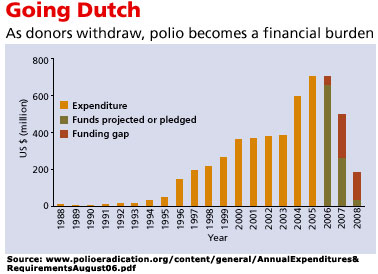


gpei began in 1988. The polio eradication programme involved administering multiple doses of the oral polio vaccine to all children in affected areas. The doses were administered in pulses: all children below the age of three in an area were inoculated simultaneously. us $5 billion have been spent under the programme. Consequently, 190 countries are polio-free. The disease remains endemic in four countries: India, Afghanistan, Pakistan and Nigeria. These countries have spread polio to 12 other countries which had freed themselves of polio. This year, these countries accounted for only 8 per cent of all polio cases: a significant drop from the 60 per cent last year.
But the four high-risk countries have put a spanner in gpei’s works. In 2003, only 784 polio cases were reported all over the world.But the incidence of the disease has risen to 1,763, this year with more than 1,654 of them in the high-risk countries. Since 2003, around us $50 million has been used to carry out control measures in these countries, says who spokesperson Sona Bari. For example, it took us $6.1 million to control the epidemic in Namibia, where even adults were found susceptible (see map: 1,763). [2]
But now funds seemed to be drying out (see graph: Going Dutch). The agencies at the helm of gpei had estimated that governments in a polio-free world would save around us $1.5 billion in vaccine, treatment and rehabilitation costs each year. That western Europe would save us $200 million a year and the savings for the us would amount to us $230 million a year.  This was a major motivation for the developed countries to put in money in the project. Globally, the cost-effectiveness ratio of polio eradication was estimated at an impressive us $ 52.50 per disability-adjusted life year (daly) saved. It was also estimated that failure to root out polio would result in at least 10.6 million new cases of polio worldwide in the 40 years since 1988, representing the loss of 60 million dalys
This was a major motivation for the developed countries to put in money in the project. Globally, the cost-effectiveness ratio of polio eradication was estimated at an impressive us $ 52.50 per disability-adjusted life year (daly) saved. It was also estimated that failure to root out polio would result in at least 10.6 million new cases of polio worldwide in the 40 years since 1988, representing the loss of 60 million dalys
Links:
[1] http://admin.indiaenvironmentportal.org.in/feature-article/disinvestment
[2] http://admin.indiaenvironmentportal.org.in/Full6.asp%3FFolderName%3D20061231%26amp%3BFileNAme%3Dnews%26amp%3Bsid%3D35%26amp%3Bsec_id%3D9%23map
[3] http://admin.indiaenvironmentportal.org.in/category/newspaper/down-earth
[4] http://admin.indiaenvironmentportal.org.in/category/thesaurus/children
[5] http://admin.indiaenvironmentportal.org.in/category/thesaurus/vaccination
[6] http://admin.indiaenvironmentportal.org.in/category/thesaurus/polio
[7] http://admin.indiaenvironmentportal.org.in/category/thesaurus/nigeria
[8] http://admin.indiaenvironmentportal.org.in/category/thesaurus/afghanistan
[9] http://admin.indiaenvironmentportal.org.in/category/thesaurus/pakistan
[10] http://admin.indiaenvironmentportal.org.in/category/thesaurus/india